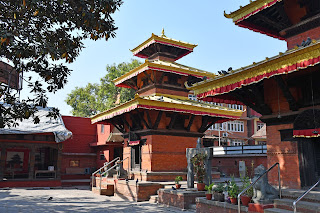Nepal – Day 2: Central Kathmandu
As our tour group was supposed to arrive some time before noon, my dad and I made a trip to the more modern, eastern part of central Kathmandu in the morning. We walked to the Narayanhiti Palace (which does not open until 10:30 on most days), after which we headed south to the Clock Tower and the Jame Masjid. Despite no longer housing a royal family, the palace receives heavy armed protection nowadays, which is ironic considering it witnessed one of the most shocking massacres in modern Nepali history when the king was still in office.
In 2001, the Nepali
crown prince murdered his entire family before turning the gun on himself. His
alleged motive was the royal family’s opposition to his choice of partner. The
throne then passed to the unpopular uncle of the deceased king, who was deposed
in 2008 after attempting to seize power from parliament in an authoritarian
coup. Conspiracy theories still shroud the entire event; the most significant one
states that the crown prince was framed by his power-hungry relative – a theory
strengthened by the fact that both the uncle and his son escaped without
injury.
From Jame Masjid, we
returned to the centre with its narrow and pleasantly shaded streets, heading
up north again to our hotel in Thamel. It is a shame that many interesting
sites are not accessible for most of the year. From one of the road bridges
leading into the centre, we spotted the Rani Pokhari Pond surrounding the
beautiful, lotus-white Matrikeshwor Mahadev Temple. According to Wikipedia, the
complex only opens on one day of the year for the festival of Bhai Tika.
Our tour group arrived
a little earlier than it was supposed to, but we managed to get back to the
hotel before them. They seem like alright bunch, though I am sure we have more
than enough time to ruin the comradely spirit with petty antagonisms. Together,
we ventured into Kathmandu once more, though at a much more leisurely pace than
the one my dad and I adopted when we were alone. In fact, we mostly stayed
around Thamel, though I was shocked at how many things we saw this time round
that we did not spot before.
We visited several
temples, only one of which we had stopped by yesterday. The tour guide told us
quite an interesting story about it: legend has it that Kathesimbhu Stupa has
not always stood where it does now. While visiting Varanasi, a Nepali holy man
was challenged to build a temple. As he lay plank to plank and brick to brick,
the populace was amazed to see a beautiful round stupa raised before their
eyes. Being excessively proud, however, the people outwardly derided it, saying
it would be much more appropriate in Nepal. The holy man responded by
commanding the stupa to move, upon which the building grew legs and walked all
the way to Kathmandu.
We also saw a little corner
dedicated to the god of curing toothaches. People used to nail coins to the
wooden idol until it was covered up in a glass structure, which is now so
opaque because of the pollution that one can barely see inside. Nevertheless,
believers have begun to nail coins around the glass casing as well, which stand
as a testament to the resilience of folk religiousness.
Our final stop for the
day was the Garden of Dreams, one of Kathmandu’s very few parks, though one where
entrance comes at the price of 400 rupees. Constructed in 1920, the park
buildings reflect the Rana regime’s fascination with British architecture:
their neoclassical facades feel genuinely out of place after an afternoon spent
in the centre. Interestingly, the park was renovated with money from the
Austrian government.
Dinner plans drove our
group apart. I am not sure what the others did, but my dad and I went to buy a
few souvenirs. At one point, while he was making a deal with a stonemason, I
noticed a menu on the street advertising a restaurant on the building’s second
floor. The restaurant offered thukpa, a kind of Himalayan noodle soup that I had
never tasted before. We climbed the stairs, therefore, arriving in a dark room
with six or seven European-style tables and a large table for those sitting on
the floor. The wooden furniture was all blackened by cigarette smoke, which now
emanated from two groups of Nepalis despite their positions staked out near the
windows.
By an interesting
coincidence – we are departing for Bhutan tomorrow – the all-male clientele
were intently watching a live broadcast of a friendly Nepal-Bhutan football
match. When we asked our waiter who he thought would win, he did not hesitate:
“Nepal always wins,” he grinned. The audience was thus visibly surprised when
Bhutan, which was clearly playing the better game, scored the first goal. As we
would find out the next day, the match resulted in a rare draw.







































Comments
Post a Comment